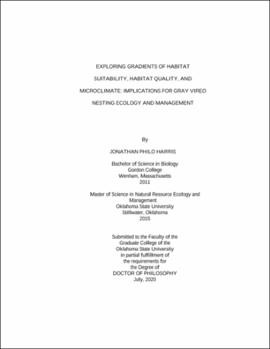| dc.contributor.advisor | McMurry, Scott | |
| dc.contributor.author | Harris, Jonathan Philo | |
| dc.date.accessioned | 2021-02-22T22:24:03Z | |
| dc.date.available | 2021-02-22T22:24:03Z | |
| dc.date.issued | 2020-07 | |
| dc.identifier.uri | https://hdl.handle.net/11244/328604 | |
| dc.description.abstract | Gray Vireos are one of the most understudied songbirds in North America and are considered a species of conservation concern for multiple state and federal agencies. I sought to address some of the gaps in our understanding of the species' habitat requirements and ecology, using a novel approach of spatially quantifying an index of habitat quality, and by evaluating their nesting strategy as an evolutionary mechanism to control microclimate. | |
| dc.description.abstract | i) I studied Gray Vireo nest-site selection at three spatial scales: the nesting tree, the vegetation surrounding nests, and within territories. Gray Vireos selected nesting trees that were taller and wider than other adjacent junipers. Selection of vegetation characteristics surrounding nests showed a similar pattern, where nests were in areas where junipers were taller, wider, and had greater foliage density than was randomly available. Broad-scale analyses suggested that Gray Vireos selected nest sites in areas with higher proportions of junipers at low elevations (< 1954 m), and lower proportions of junipers in higher elevations (> 1954 m). | |
| dc.description.abstract | ii) Daily nest survival probabilities were estimated as a function of nest placement and fine-scale vegetation characteristics. Nest survival was high, with daily and overall nest survival probability of 0.98 and 0.44, respectively. Our top models included positive effects of nest-tree foliage density and nest distance from the edge of the nesting tree. | |
| dc.description.abstract | iii) I sought to quantify the proportion of selected habitat that has a high probability of contributing to population growth. Gray Vireos tended to nest in locations where they had the highest probability of nest survival. Approximately 85% of the area selected by Gray Vireos for nesting habitat had a high probability of contributing to population growth through nest survival. | |
| dc.description.abstract | iv) The microclimate of Gray Vireo nests was monitored to evaluate the thermal benefits of nesting on the periphery of a nesting substrate through orientation. Nests were on average 3 degrees C cooler than the opposite orientation of the nesting tree at the hottest times of the day (1700-1830). Nests also received significantly less light exposure throughout the day than the opposite orientation of the nesting tree. | |
| dc.format | application/pdf | |
| dc.language | en_US | |
| dc.rights | Copyright is held by the author who has granted the Oklahoma State University Library the non-exclusive right to share this material in its institutional repository. Contact Digital Library Services at lib-dls@okstate.edu or 405-744-9161 for the permission policy on the use, reproduction or distribution of this material. | |
| dc.title | Exploring gradients of habitat suitability, habitat quality, and microclimate: Implications for Gray Vireo nesting ecology and management | |
| dc.contributor.committeeMember | Smith, Loren | |
| dc.contributor.committeeMember | Davis, Craig | |
| dc.contributor.committeeMember | Loss, Scott | |
| osu.filename | Harris_okstate_0664D_16899.pdf | |
| osu.accesstype | Open Access | |
| dc.type.genre | Dissertation | |
| dc.type.material | Text | |
| dc.subject.keywords | gray vireo | |
| dc.subject.keywords | habitat quality | |
| dc.subject.keywords | microclimate | |
| dc.subject.keywords | nest-site selection | |
| dc.subject.keywords | pinyon-juniper woodlands | |
| dc.subject.keywords | vireo vicinior | |
| thesis.degree.discipline | Integrative Biology | |
| thesis.degree.grantor | Oklahoma State University | |
